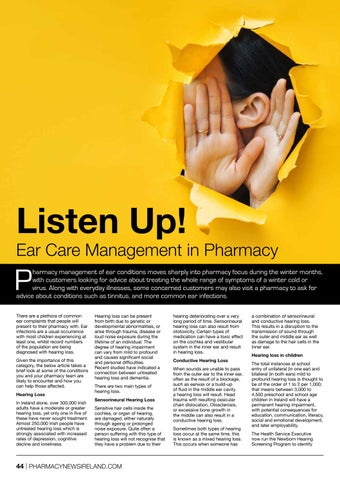Listen Up!
Ear Care Management in Pharmacy
P
harmacy management of ear conditions moves sharply into pharmacy focus during the winter months, with customers looking for advice about treating the whole range of symptoms of a winter cold or virus. Along with everyday illnesses, some concerned customers may also visit a pharmacy to ask for advice about conditions such as tinnitus, and more common ear infections.
There are a plethora of common ear complaints that people will present to their pharmacy with. Ear infections are a usual occurrence with most children experiencing at least one, whilst record numbers of the population are being diagnosed with hearing loss. Given the importance of this category, the below article takes a brief look at some of the conditions you and your pharmacy team are likely to encounter and how you can help those affected. Hearing Loss In Ireland alone, over 300,000 Irish adults have a moderate or greater hearing loss, yet only one in five of these have never sought treatment. Almost 250,000 Irish people have untreated hearing loss which is strongly associated with increased rates of depression, cognitive decline and loneliness.
Hearing loss can be present from birth due to genetic or developmental abnormalities, or arise through trauma, disease or loud noise exposure during the lifetime of an individual. The degree of hearing impairment can vary from mild to profound and causes significant social and personal difficulties. Recent studies have indicated a connection between untreated hearing loss and dementia. There are two main types of hearing loss. Sensorineural Hearing Loss Sensitive hair cells inside the cochlea, or organ of hearing, are damaged, either naturally through ageing or prolonged noise exposure. Quite often a person suffering with this type of hearing loss will not recognise that they have a problem due to their
44 | PHARMACYNEWSIRELAND.COM
hearing deteriorating over a very long period of time. Sensorineural hearing loss can also result from ototoxicity. Certain types of medication can have a toxic effect on the cochlea and vestibular system in the inner ear and result in hearing loss. Conductive Hearing Loss When sounds are unable to pass from the outer ear to the inner ear, often as the result of a blockage, such as earwax or a build-up of fluid in the middle ear cavity a hearing loss will result. Head trauma with resulting ossicular chain dislocation, Otosclerosis, or excessive bone growth in the middle can also result in a conductive hearing loss. Sometimes both types of hearing loss occur at the same time, this is known as a mixed hearing loss. This occurs when someone has
a combination of sensorineural and conductive hearing loss. This results in a disruption to the transmission of sound through the outer and middle ear as well as damage to the hair cells in the inner ear. Hearing loss in children The total instances at school entry of unilateral (in one ear) and bilateral (in both ears) mild to profound hearing loss is thought to be of the order of 1 to 2 per 1,000; that means between 3,000 to 4,500 preschool and school age children in Ireland will have a permanent hearing impairment, with potential consequences for education, communication, literacy, social and emotional development, and later employability. The Health Service Executive now run the Newborn Hearing Screening Program to identify



